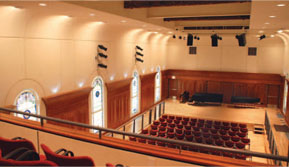AV for the Performing Arts

At Southeast Missouri State University's School of Visual and Performing Arts, finished sound systems blend old and new technologies.
Managers of performing arts building projects have a tough job. Witness the design and construction of the Earl and Margie Holland School of Visual and Performing Arts at Southeast Missouri State University.
The 205-seat Robert F. and Gertrude L. Shuck Recital Hall was originally a 150-year-old campus chapel. Photo courtesy Michael Kessell, CTI. and construction were to be finished on time.
This particular nine years, however, saw a revolutionary change in high-end audio systems - a shift from mainly analog to completely digital technology. "If this project were designed today, it would be very different," Lahey explains. Yet because the sound systems were so integral to the design and construction of the facilities, much of it was literally "cast in concrete" - significant change was not an option.
Perhaps for that reason, by the end of the summer of 2007, it became obvious that the original sound contractor would not have the systems ready for the grand opening in October, and that there were issues in their design that had not been addressed. At that point Jeff Lovett, technical director for the Holland School, brought in Conference Technologies to replace the original contractor.
"Our job," says Lahey, "became one of bringing the initial designs up to date, making sure that the digital components added later worked smoothly with the [pre-existing] wiring and conduit that could not be changed."
A NEW PERFORMING ARTS CAMPUS
The overall goal of this project was extremely ambitious: to create a top-tier college of performing arts and, with it, a state-of-the-art cultural arts center.
A daily selection of features, industry news, and analysis for tech managers. Sign up below.
The development began in 1998 with the purchase of the buildings and grounds of St. Vincent's College and Seminary on the banks of the Mississippi, which had been closed in the 1980s. Southeast Missouri State University created the School of Visual and Performing Arts that year, comprised of the departments of Art, Music, and Theatre/Dance. They also formed a partnership with the City of Cape Girardeau to provide public and private funding for the new facility.
The University preserved and re-used the historical structures and built a new facility with two theaters, a dance studio, art museum, classrooms, practice rooms, labs, and offices. The seminary's chapel would be gutted and rebuilt as a recital hall. Ground was broken in May 2003 on what would be a $160 million project.
THE NEED FOR DIGITAL SOUND
Working with plans developed by Arup Acoustics and Sound Design of Los Angeles, Conference Technologies completed the engineering and installation of sound systems in four major venues in the new River Campus, together with an HD video system in a theater in the Rosemary Berkel and Harry L. Crisp II Museum of Fine Art.
The 950-seat Donald C. Bedell Performance Hall is the center's largest theatrical space. Its first year of operation saw touring productions of The Producers, the Moscow Ballet performing The Nutcracker, the St. Petersburg Ballet, Ring of Fire, Shaolin Warriors, Hal Holbrook's Mark Twain Tonight, and visits from the St. Louis Symphony, as well as the Southeast Missouri Symphony Orchestra and a number of student productions.
"What you need for a touring musical is completely different than for a ballet," says Lovett. "The challenge of building this sound system was that we are so versatile - there is no one type of system perfect for us."
"[The musical production] Stomp played here in October," he explains. The producers of that show require a stage-mounted ground stack system, so the dancers can actually feel the vibrations of the music as well as hear them. "But our system is flexible enough that, instead of giving them full ground stacks, we were able to add some small stacks to give them the feel they want. Our job here is to take each unique event and figure out how to make it work without bringing in a lot of rental gear."
The distributed sound design uses Renkus- Heinz STX6/64 loudspeakers for left, right, and center mains, two Community SBS45 subwoofers, Renkus-Heinz TRX121/9 loudspeakers for the sides and three balcony satellite fill positions, Renkus-Heinz TRX61 speakers for six front of stage lip fills, and 30 Tannoy CMS60-TDCs as under-balcony and under-mezzanine fills - all driven by a stack of 17 various Crown CTs series amps. The system includes a combination of two Biamp AudiaFlex and a Biamp AudiaExpo digital signal processors, nearly 150 positions in which to plug the many Shure wired and wireless mics, and thousands of different ways to patch them and other audio sources though the Soundcraft MH4 32-channel mixer. It also includes numerous sound effects units.
The hall is set up for video production as well. "You can just plug in your cameras to do a live remote for television," Lahey explains. CTI installers routed video input plates throughout the hall to video patchbays in the control room racks, where they also included Sigma distribution amps and Blonder Tongue channel insertion units for sending the signal out over the campus cable system.
In addition to the front-of-house systems, there's distribution of audio into the lobby and backstage, paging systems, assistive listening systems, and intercom. "One interesting challenge came from our chain-driven pit lift," says Lovett. "We have speakers mounted on the front lip of the hard stage. But when the orchestra pit lifts up and becomes part of the main stage, there's a different set installed there. A muting system mutes the speakers on the main stage and activate the ones on the pit lift."
The 180-seat Wendy Kurka Rust Flexible Theater is a "black box" theater, built to be set up in any configuration from traditional performances to theater in the round. "They tend to be a little more avant garde in there," says Lovett. This year's schedule includes the one-act Sister Mary Ignatius Explains it all For You, part one of the 8-1/2-hour Angels in America, A Midsummer Night's Dream, and student dance concerts.
The Flexible Theater includes a large number of connections for microphones, speakers, lights, and other gear - even the sound and lighting boards can be moved into any of four locations in the room. CTI installed a basic loudspeaker system to ensure overall sound coverage, but producers typically hang additional speakers depending on the seating setup and the need for directional effects.
The 205-seat Robert F. and Gertrude L. Shuck Recital Hall, created from the seminary's 150-year-old chapel, is used mainly for student and faculty recitals. "Because that hall is designed like a typical European music hall," says Lovett, "it has a 2.25-second natural reverb." CTI sound engineers used EAW's Smaart sound system analysis software to carefully set the EQ and limiting functions in the AudiaFlex DSP. To use Smaart, engineers play pink noise through the sound system, then pick it up on a high-quality microphone plugged directly into the computer. The computer compares the output of the loudspeakers to the original, and the engineer adjusts the system frequency by frequency until everything matches perfectly.
The engineer normally must bring his judgment and experience into the process, since the computer alone cannot allow for intangible factors that create the unique sound of the hall. For this reason, he will make occasional checks with recorded music. In the Shuck Recital Hall, the long reverb time required significant adjustment to the curve displayed by the software, especially at the lower frequencies.
The Dance Studio is used mainly for instruction and rehearsals, with audio sourced from CD players and iPods. "That's a really beautiful space," says Lovett. "It has a wall of windows that look out over the Mississippi." He reports that the studio is used almost constantly, from 8 in the morning to midnight each day.
The theaters, too, are extremely busy. Lovett reports that, "in October alone, we had over 20 performances, plus instructional use."
EDUCATIONAL TOOLS
One of the most important concerns for each of these sound systems - and one reason Lahey was determined to include as much digital equipment as possible - was the fact that they would be used as learning devices for theater technology students. "We couldn't have something they can't touch," Lovett explains. "These systems had to be hands-on, flexible, and user friendly."
The Rust Flexible Theater was built mainly for instruction, with the majority of shows student- produced. "The booth is used as a sound and lighting classroom," Lovett says. "Our stage combat classes are taught in there. Acting and auditioning are taught in there."
The Bedell Performance Hall is also used for classes, though not as constantly. "They use it when they need to teach certain aspects of theater you cannot teach in another setting," Lovett explains. Students come in to learn how to set up theater fly systems, for example, or to become familiar with larger sound systems. They'll have sessions on lighting a proscenium stage. For that reason, it's especially crucial that every setting can be restored in moments so a show, perhaps that evening, can go on as though no one touched the systems.
MEETING THE DEADLINE
Coming into the project only six weeks remaining before the opening, Lahey and his crews had to scramble. "Conference Technologies brought in their own equipment at their own cost so we would have a working sound system," says Lovett. "The opening ceremonies and the first shows were successful strictly because they made the extra effort to bring down rental equipment and get us up and running." Over the next ten months CTI completed the installations and straightened out a number of problems caused by the age of the design and the complexity of the demands that would be placed on it. "It was a combination of newer and older technologies that had to be melded together," Lovett says.
"Wayne Garber came up from CTI's Memphis office and did a wonderful job on the wiring," Lovett says. "There are a tremendous number of Whirlwind Mass connects that he had to individually punch in [over 5200 pin connections]. We also have some extremely complex patchbays - the Bedell theater, itself, has nearly 650 patchpoints. [The rooms used a total of 12 Middle Atlantic racks.] Mike Kessell's racks are incredibly clean. I'm someone who has done installations before, and these racks are gorgeously wired."
Although the AV systems are not on the campus data network, Cat-5 data ports and cabling were installed throughout the halls, along with patchbays in the control rooms, for accessory/future use.
"Mike has a very intense background in audio and made a world of difference on this job," Lahey explains. "It could not have been done without his dedication, long hours, and many long nights on the site." Lovett adds that "Most important is the fact that Mike kept asking, 'What do you guys actually need?' CTI did a great job of taking what we had and making it work for us."
